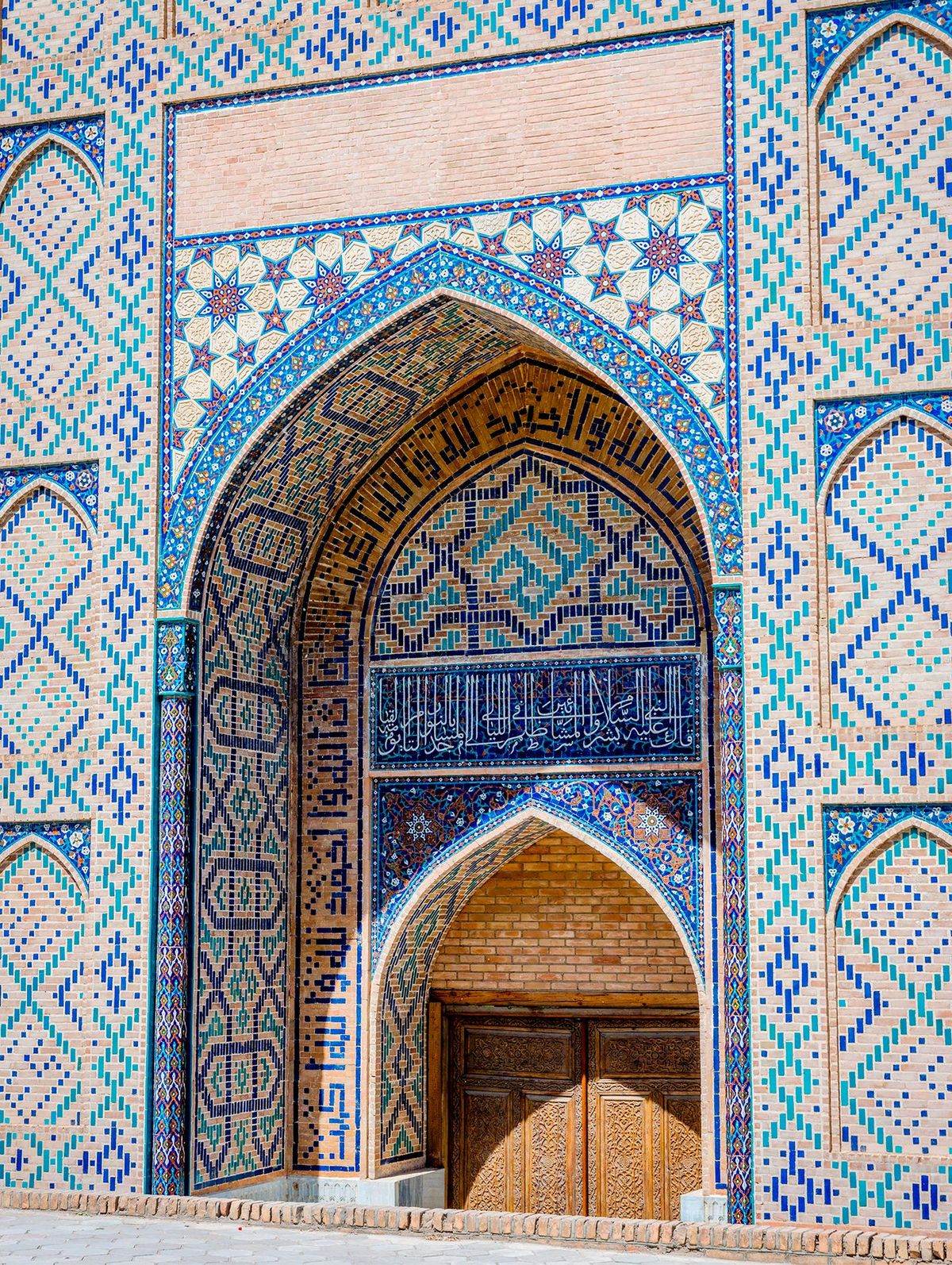WORDS
Ian Belcher
Dusk. Whispering dusk. In Uzbekistan’s Kyzylkum Desert, the day is bleeding away, the sand grey, the scrub menacing – a spectral half-light that fires the imagination. I picture caravans of merchants padding through the desolate wilderness, their camels bearing silks, spices and jade, perhaps furs, and tethered slaves.
I’m relying on 4WD rather than dromedary hooves, but Central Asia’s Silk Road – the elongated web of trading routes that linked eastern China with western Europe for 1500 years – remains an enticing, mystical drive.
My photogenic starting line is the oasis of Khiva, where medieval mud walls encircle a labyrinth of 18th- and 19th-century minarets, mosques, mausoleums and madrasas. Beautiful buildings, ugly history. Khiva was a slave trading outpost ruled by Turco-Mongol descendants of Genghis Khan. Their cruel punishments included impalement on stakes, deliberately blunted to prolong suffering, eye gouging and live burial in the surrounding steppe. Khiva’s warriors’ robes reflected their toll of beheadings.
It’s less intimidating today as I depart past the “Executioners’ Gate”, navigating around savage potholes as agricultural flatlands surrender to mustard-hued desert. Bukhara, 266 miles to the east, is Central Asia’s holiest city, a centre of Islamic teaching, culture and trade, once home to 100 madrasas and 300 mosques.
Many remain. I’ve allowed a day to explore. Bukhara deserves far more. One showstopper follows another: Lyabi-Khauz’s monumental buildings, Poi-Kalyan Square, whose 12th-century minaret, from which prisoners were flung to their death, was the world’s tallest freestanding building at the time, and the Ark Citadel, a seat of power since 500AD, whose 3,000 inhabitants included scientists, poets and philosophers. Most striking is the Bolo-Khauz Mosque, with elegant carved-wood pillars; most disturbing, Zindon Prison’s Bug Pit, entered down a long rope.

Punch drunk with grandeur, I make for a modest, open-fronted shop neighbouring a 16th-century bathhouse. Silk Road Spices is the ultimate heritage brand. Apart from an enforced 50-year break under Soviet rule, the Ubaydov family has operated on this spot since 1400. Sacks of ginger, saffron and cinnamon decorate a wood counter backed by brass teapots. ‘Knowledge has been passed down by word of mouth from my ancestors,’ explains owner and spice master Mirfayz Ubaydov. ‘Nothing is written.’

Ingredients such as Sri Lankan cloves, Chinese star anise and Zanzibar pepper are blended into medicinal teas for clients that include Hillary Clinton and King Charles III.
Today, however, it’s just me and an elderly gent in a Karakul hat discussing his ailments. I leave with a Mirfayz mix to stay alert behind the wheel.
I’ll need it. The flat featureless desert dulls the senses. But that’s about to change. Next morning, the road bisects miles of cherry blossom beneath distant hills. Samarkand proves any fear of becoming jaded by architectural drama – Oriental Overload or Silk Road Saturation – are unjustified. Registan Square’s three exquisitely tiled madrasas are magnificent. If you can’t fall silent here, there’s no hope.

I also stand before the azure dome adorning the tomb of Timur. Samarkand’s famous warrior son, whose conquests killed an estimated 17 million people, is dubbed “the tyrant’s tyrant”. Given the region’s rulers, that’s some accolade. Just as nearby Karimbek is some restaurant. Betraying the heavy hand of Google Translate, its dishes include Salad with Base Meat Birds, Pig Lump and Lady Whim. I order a kebab.
As on the best road trips, time appears to accelerate. Heading north, I face meandering livestock, a man asleep on a cart towed against the traffic by a donkey, and regular police checks. A day of thunderous downpours is devoted to Tashkent’s wide boulevards and stern Soviet buildings, before I reach southern Kazakhstan’s empty grasslands. For two days, I run parallel to the snow-licked spine of the Kyrgyz Ala-Too range, part of the enormous Tien Shan chain of mountains. Rising to 14,500 feet, they include the summit christened “Vladimir Putin” in 2011. You won’t see that in Europe’s Alps.
Now, the landscape takes centre stage.
From Kyrgyzstan’s capital Bishkek, I push deeper
into the Tien Shan, chasing the emerald-hued
River Chu through a gorge of rich-red rocks.
Around Issyk-Kul, the second-largest mountain
lake on Earth, the roadside is littered with
detritus from Kyrgyzstan’s communist past:
hammer and sickle emblems, rusting statues
of Lenin and space-race rockets.
My target is the Aurora, a shoreline sanatorium hotel and former haunt of Russian presidents and heroic cosmonauts. It’s so Brutalist it makes the Barbican look positively Baroque. Staff in crisp naval uniforms enforce a Stalinist timetable that decrees supper, including a starter of cabbage salad and hot rice pudding, finishes up by 7pm.
Forget candlelit ambient grooves, the Aurora’s therapies are seriously medicalised: intestinal irrigation, high-pressure hosing. A mud bath appears the safe option. Cue a consultation with a concerned doctor and her stethoscope. ‘It’s your heart valves,’ sighs my interpreter, who clearly harbours B-movie ambitions. ‘They aren’t opening properly.’
‘Dear Lord, I only wanted a mud bath.’ ‘That,’ growls the interpreter, ‘could be dangerous.’
The good doctor intervenes, reassuring me it’s merely a quiet heartbeat, her diagnosis confirmed by a 1970s tickertape electrocardiogram. Displaying a suicidal approach to turning a profit, she prescribes a mineral bath, a second doctor’s appointment and an ultraviolet laser up my nostril to zap any infection. I’m finally declared fit for Ainagul, a therapist with red hair, gold teeth and Popeye forearms. Smothered in thick goo, I’ve earned my divine 42˚C mud baste.
Shiny, refreshed and refuelled, I skirt around Issyk-Kul’s shoreline. After breaking to construct a yurt with local nomads for a final night’s kip, I join a glorious road rising through mountains crinkled with ravines and frescoed with shadows of passing clouds. China’s icy border lies just ahead but, in a superlative act of choreography, a passing train of camels provides the perfect chequered flag for my Silk Road odyssey.
A 21-day journey across Central Asia, taking in Kyrgyzstan, Uzbekistan, Turkmenistan and Kazakhstan, costs from £5,980pp, excluding flights; steppestravel.com





